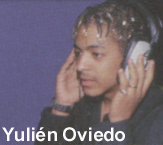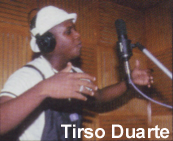Indice - Table of contents
New Stuff[hide]
Musicos: Rafael Paseiro Monzón
Musicos: Dennis Nicles Cobas
Musicos: Jiovanni Cofiño Sánchez
Musicos: Yasser Morejón Pino
Fotos: Tom Ehrlich : 2024 Monterey Jazz, P...
Resenas: Vacilón Santiaguero (Circle 9 ...
Staff: Bill Tilford
Fotos: Tom Ehrlich : 2024 Monterey Jazz, P...
Fotos: Tom Ehrlich : 2024 Monterey Jazz Fe...
Fotos: Tom Ehrlich : testing 123
Grupos: Pupy y los que S... : Discography - 1995- F...
Reportes: From The St... : Cubadisco 2...
Reportes: From The St... : Jazz Plaza ...
Fotos: Tom Ehrlich : Irakere 50th Annivers...
Photos of the Day [hide]
SpanishEnglishStudy - Conversations in Timba


CONVERSATIONS IN TIMBA
Charanga Habanera's
"Tema Introducción"
by Kevin Moore ©2002
The musical examples in this article are from MIDI recordings made by Tirso Duarte and Yulién Oviedo of Charanga Habanera. The last section explains how the recordings were made and discusses the subject of using MIDI to study Timba.
"Tema Introducción" is a great example of the many levels of rhythmic and melodic "conversation" in Timba. By soloing and muting various tracks in a MIDI arrangement of this song, we can begin to unravel some its many contrapuntal wonders and look at the differences between Timba and Salsa in much more specific detail.
[click here for the lyrics and structural analysis of this track]
Since we'll be using the piano part as a musical backdrop to put each "conversation" into perspective, let's start by looking at the conversation that's already going on within the piano part itself. As we've discussed, traditional salsa pianists play the same part in each hand, sometimes in octaves or other harmonies, but always the same rhythms. There's also a school of Timba pianists who do this. Among the most famous are Juan Carlos González of the first Charanga Habanera, Eduardo "Chaka" Nápoles of Manolín, and Lázaro Valdés of Bamboleo. But the majority of Timba pianists play a different rhythm which each hand, including our present subject, Tirso Duarte. In the main tumbao of "Tema" the left hand plays running sixteenths, and if it weren't for the Afro-Cuban accents in the phrasing, it would sound very much like J.S. Bach. It also has a little taste of the theme from "The Godfather"! Here's just the left hand, with clave. [audio example 1]. The right hand plays a sparser, highly syncopated part. [audio example 2]. Now listen to them together [audio example 3]. At the end of each example the most basic bass tumbao, which starts on the down beat of "1", is added, just to make the orientation of the piano tumbao crystal clear since you'll need to hold onto it for dear life when the bloque comes in!
The secondary tumbao of "Tema" is based on the secondary tumbao of "Charanguéate", a song from "Tremendo Delirio" that the new Charanga Habanera frequently plays live. In our main article on "Charanguero Mayor" you can hear an exhilarating live performance which segues from the end of "Charanguéate" into "Tema". Based, as it is, on a Juan Carlos González tumbao, both hands play similar rhythms, but even here Tirso throws in an extra note in the right hand. Here's the second tumbao of "Tema" [audio example 4], and its predecessor can be heard at the end of this excerpt from the original Charanga Habanera's version of "Charanguéate" for comparison. [audio example 4b]
The third element of the arrangement is a truly wild bloque that's repeated 6 times [audio example 5].Until you learn to hear it, this bloque can turn you upside down and inside out! Many of Charanga Habanera's arrangements play a game of "Where's One?" at the very beginning, where it's easy to disorient the listener, but this time, they set up the groove and give you plenty of time to get in the pocket before they hit you with the bloque. Part of the challenge is that the bass and horns play different variations of the figure. Here's how it looks when it's written out:

The top line is the horns and the bottom the bass, starting a bar before the bloque.Here's just that section in super-slow motion [audio example 5b]. (The audio example starts on the second bar of the sheet music example).
Now listen to the actual song as recorded on "Charanguero Mayor". [audio example 6].
Quite a beast, eh? Let's put it on the operating table and examine each part of the complex polyphonic texture. The first "conversation" we want to look at is the one between the kick drum and the bass. Remember that in most salsa, there is no kick drum, and in most types of music where there is, the kick drum usually reinforces the bass and the two together form a static rhythm underpinning for the higher instruments and voices. But in many types of African drumming, such as batá music, this pattern is reversed, with the higher drums playing a more static part and the melodic interest and counterpoint taking place in the lower frequency range. Timba, while it ventures much farther into rock and jazz than traditional salsa, balances this "Western" influence with an even more potent infusion from the Afro-Cuban folkloric roots. Listen to just the bass and kick drum, with the piano tumbao playing softly in the background.[audio example 7].
Now let's move up to the middle frequency range and listen to the incredible interplay between the congas and timbales. [audio example 8].
The remaining percussion sounds are all in the higher frequency range: the timbalero's mambo and cha bells, cymbal and clave (jam block), and the bongocero's campana bell. [audio example 9].
Now let's listen to all the percussion together, plus the bass. [audio example 10] Remember that there are three percussionists in total: the conguero obviously plays just the congas, the bongocero in this case plays only the hand held campana bell, and the timbalero plays the timbales, clave, cymbal, the other bells, and the kick drum.
Next we'll listen to all the melodic instruments together, including two we haven't discussed, the synth and the horns. In this arrangement the horns just play the intro and the bloque. The synth switches between a funky contra-tumbao and, typical of Charanga Habanera, a majestic analog synth-style figure. [audio example 11]
Now we're ready to hear the complete MIDI arrangement. [audio example 12].
One of the most incredibly valuable aspects of MIDI is that it can be slowed down without changing the timbres. Here's all the percussion, plus piano and bass, at half speed. [audio example 13].





















